Rembrandt Vs. Velázquez: Dutch & Spanish Masters on Show in Amsterdam
Lot-Art had the pleasure to visit the exhibition Rembrandt-Velázquez. Dutch & Spanish Masters at Rijksmuseum in Amsterdam. This exhibition is on show from 11 October 2019 to 19 January 2020. It is the result of a special partnership between the Rijksmuseum and the Museo Nacional del Prado in Madrid, marking the Year of Rembrandt 2019 and the 200th anniversary of the Prado.
Rembrandt-Velázquez. Dutch & Spanish Masters presents an outstanding selection of paintings by Dutch and Spanish Masters of the 17th century, including some of the greatest pieces by, amongst others, Rembrandt, Velázquez, Murillo, Hals, Zurbarán and Vermeer. In this exhibition, 60 paintings by Spanish and Dutch masters hang alongside each other in pairs, resulting in fascinating visual dialogues on realism and eternity, religion and beauty.
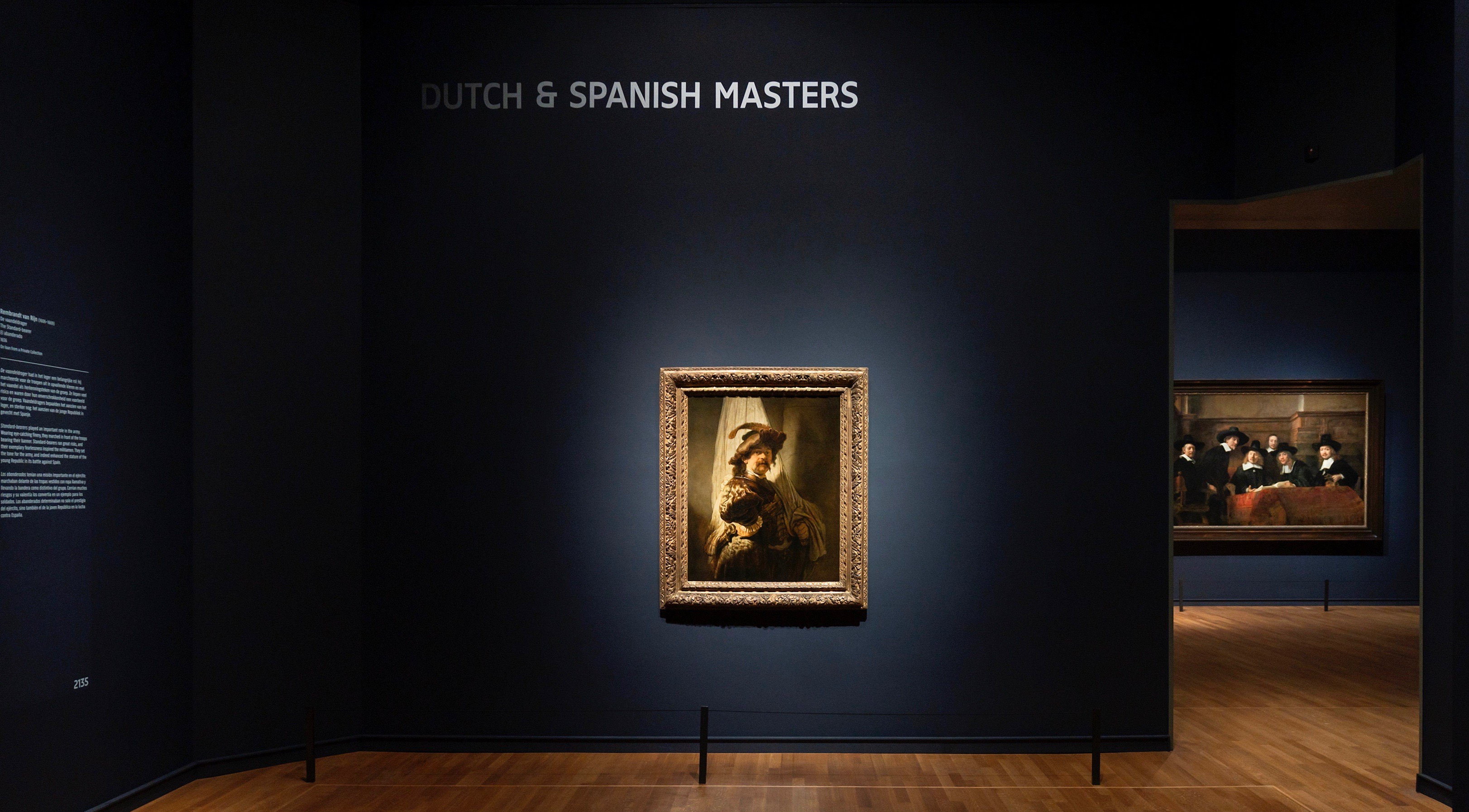
Rembrandt-Velázquez. Photo: Olivier Middendorp
Religion and Realism
During a time of war and political tension, the Dutch and Spanish painting traditions approached closer to each other than it is generally thought. The 17th century has become known as the Golden Age of painting in both the Netherlands and Spain. It was a period of tremendous artistic achievement that saw the emergence of two of the greatest painters in history, Rembrandt and Velázquez, the leading artists of their respective countries. Both masters worked in a climate that included many other painters who enjoyed great reputation, such as Zurbarán and Murillo in Spain, and Vermeer and Frans Hals in the Netherlands
Although there was no direct contact between the painters from the North and South, they show clear similarities, not only in artistic ambition but in the impulse towards realism and their illustration of religious themes.
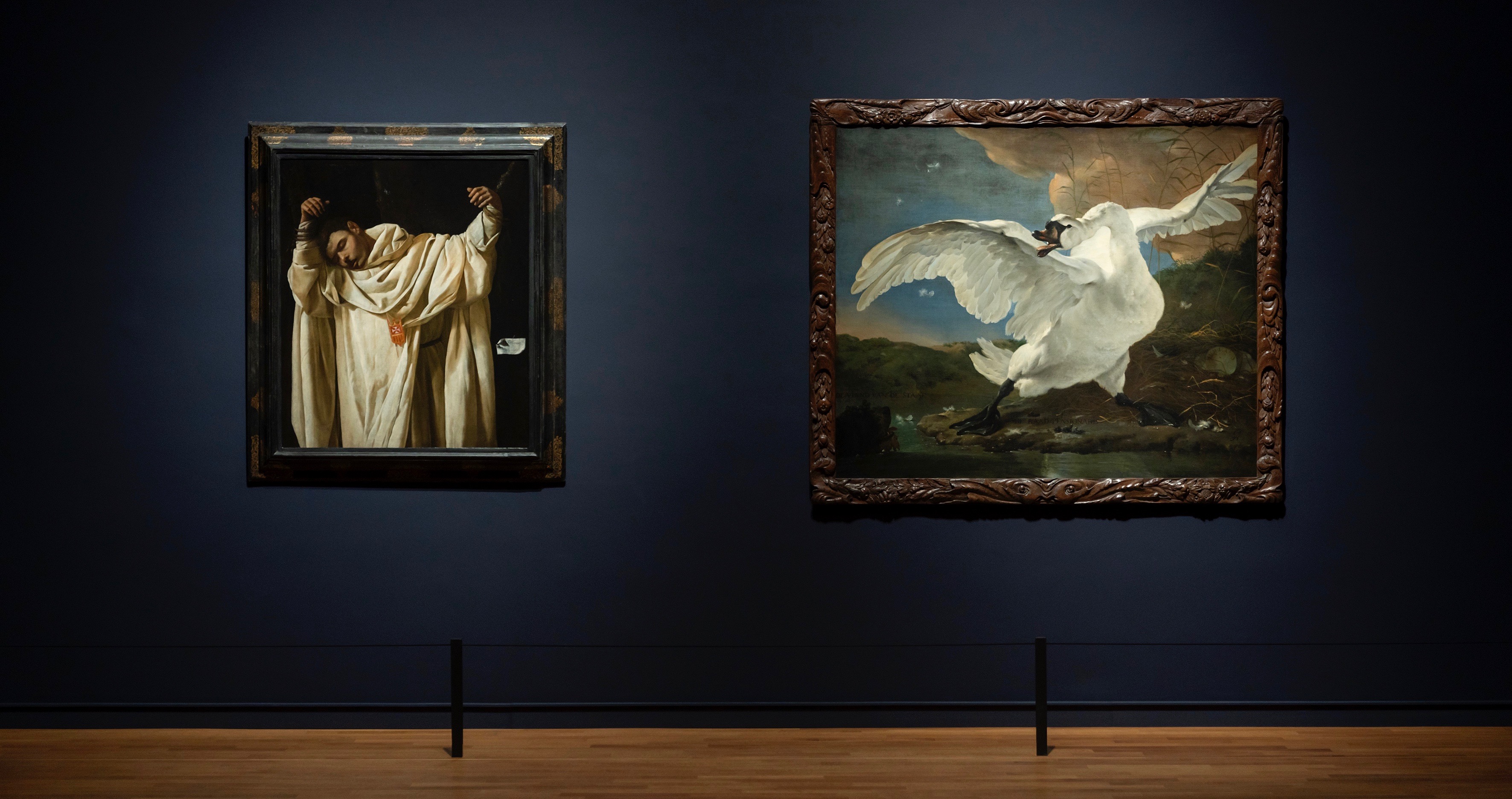
Rembrandt-Velázquez. Photo: Olivier Middendorp Left: Francisco de Zurbarán, St Serapion, 1628. Hartford (CT), Wadsworth Atheneum Museum of Art. The Ella Gallup Sumner and Mary Catlin Sumner Collection Fund; Right: Jan Asselijn, The Threatened Swan, c. 1650. Amsterdam, Rijksmuseum
Display in pairs
Paintings of highly-renowned masters are displayed in pairs, combining two works from each Country, to explore, for the first time, the stimulating and often surprising dialogues that inevitably arise between the works. By pairing the paintings together, the exhibition sheds light on their common points, although sometimes the differences might seem stronger than the similarities. Each pair has a story behind, a specific theme that brings the two paintings together. A wide variety of themes will be therefore represented: from concepts such as religion, faith, wealth or love to artistic challenges such as composition, light, and shadow.

Left: Diego Velázquez (1599 - 1660) - Vulcan's Forge, 1630 (see full-size image »); Right: Rembrandt van Rijn (1606 - 1669) - The Sampling Officials of the Amsterdam Drapers’ Guild, 1662 (see full-size image »)
An artistic challenge for every artist is to paint a large picture with a complex composition involving multiple figures. With Rembrandt and Velázquez's paintings it is as if we are looking at a still image from a film. Both contain many spontaneous movements, such as the man rising from his chair in Rembrandt's work. The scene comes to life, rising only a single question: what happens next?
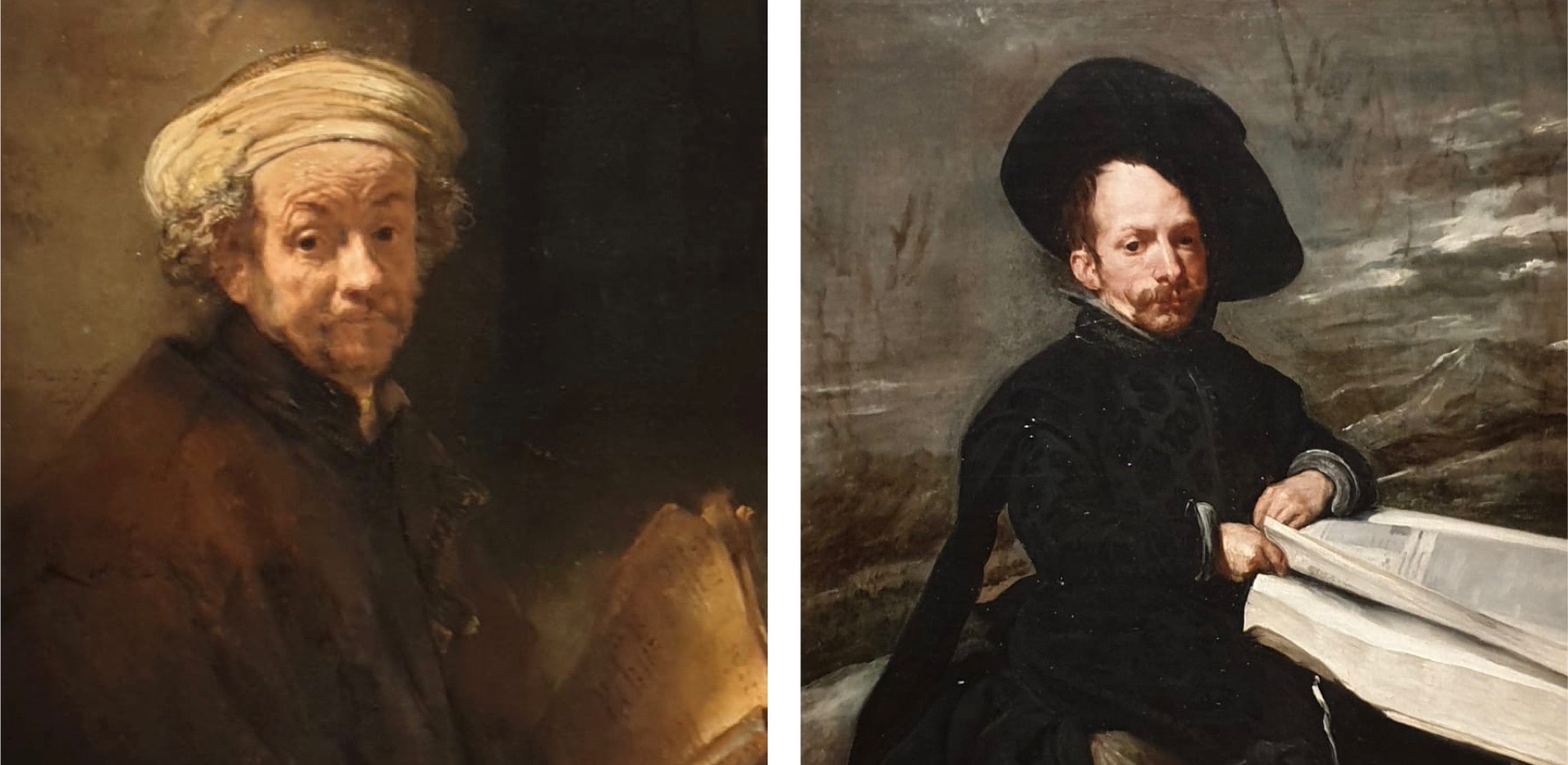
Left: Rembrandt van Rijn (1606 - 1669) - Self-portrait as the Apostle Paul, 1661 (see full-size image »); Right: Diego Velázquez (1599 - 1660) - Portrait of a man (known as Court Jester with Books) ca. 1640 (see full-size image »)
Human. In one of his last self-portraits, Rembrandt depicted himself as the apostle Paul. In no other self-portrait do we see such quizzically raised eyebrows. We are challenged to think about this individual. Velázquez also painted a little person, in his role of court jester. The Spanish master, however, saw beyond the stereotype and spotlighted the actual human being.
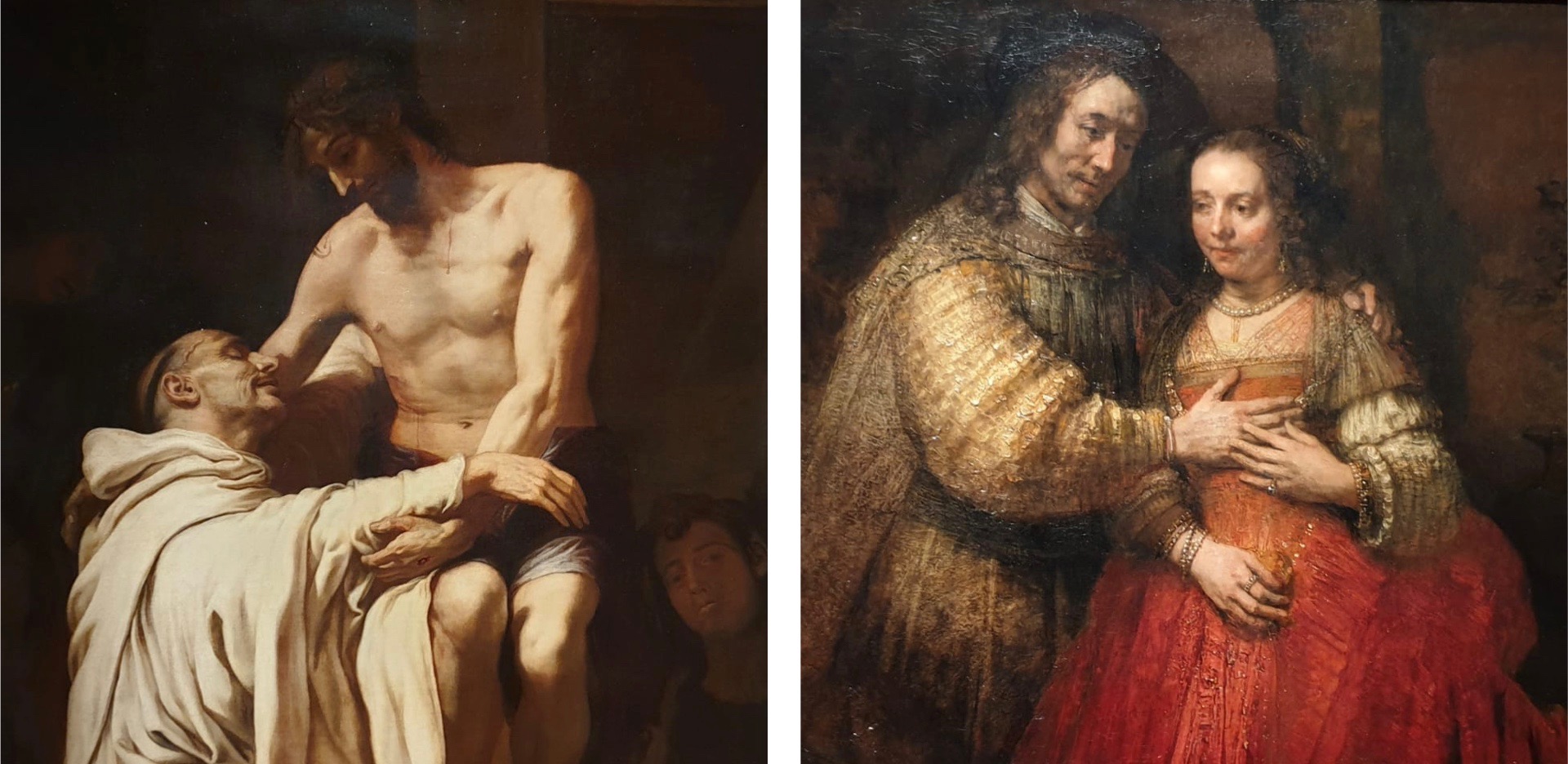
Left: Francisco Ribalta (1565 - 1628) - Christ Embracing St Bernard, ca. 1625 - 1627 (see full-size image »); Righ: Rembrandt van Rijn (1606 - 1669) - The Jewish Bride, ca. 1665 (see full-size image »)
Love - the greatest of the three Christian virtues, the other two being faith and hope. A saint, the monk Bernard of Clairvaux, experienced love directly in a moving scene: an embrace with Christ himself freed from the cross. Ribalta depicted this moment in a poignant way, just as Rembrandt portrayed the very tender, intimate physical exchange between the Biblical couple Isaac and Rebecca.
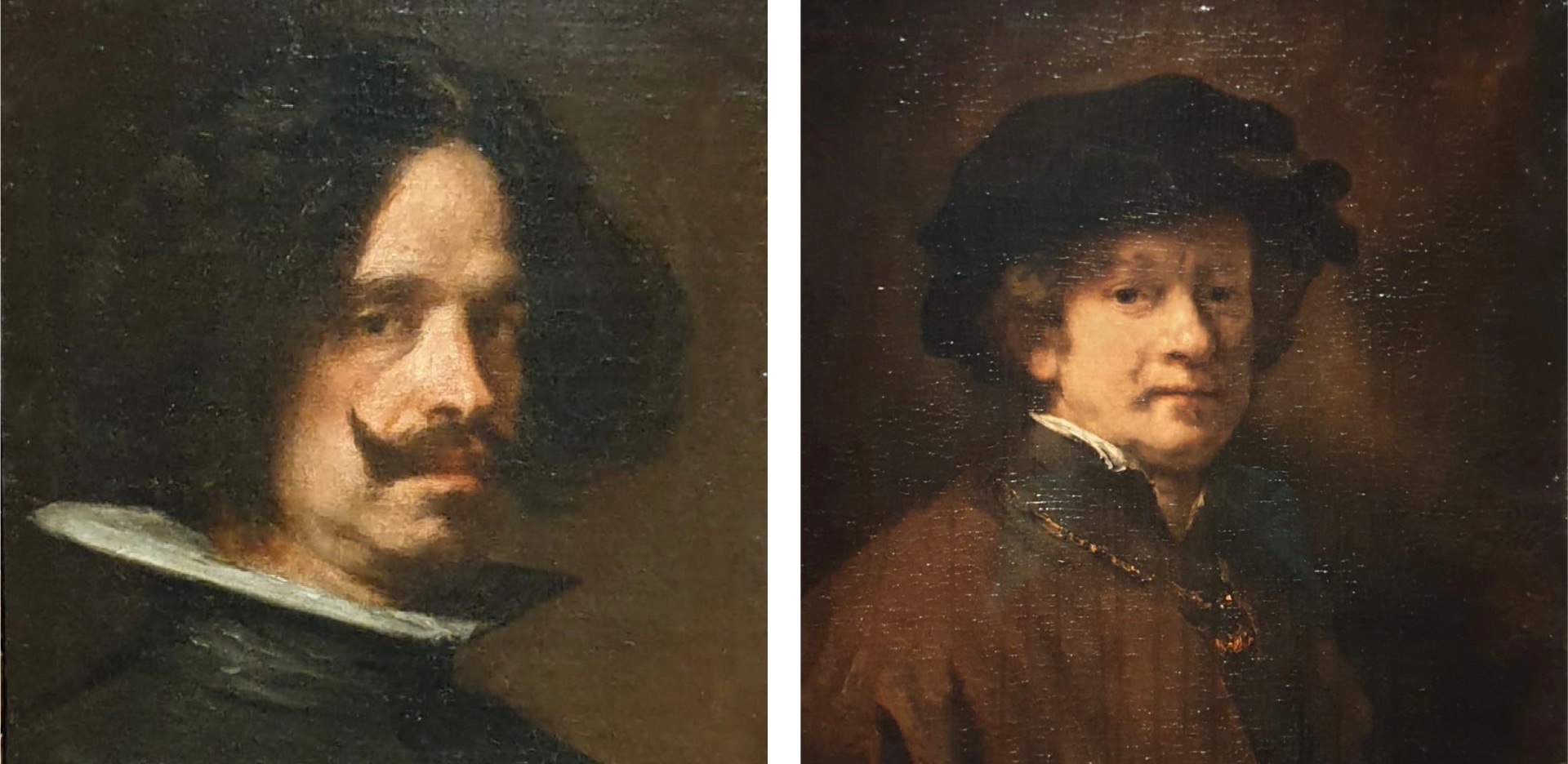
Left: Diego Velázquez (1599 - 1660) - Self- portrait, ca. 1640 (see full-size image »); Right: Rembrandt van Rijn (1606 - 1669) - Self- portrait, 1654 (see full-size image »)
Protagonists! Velázquez and Rembrandt played leading roles already in their own time, one because of his high position at the Spanish court, the other because of his influential production as a painter and printmaker. While their social environments were worlds apart, their artistic ambition and unsurpassed ability to fathom the human depths of their models hardly differed.
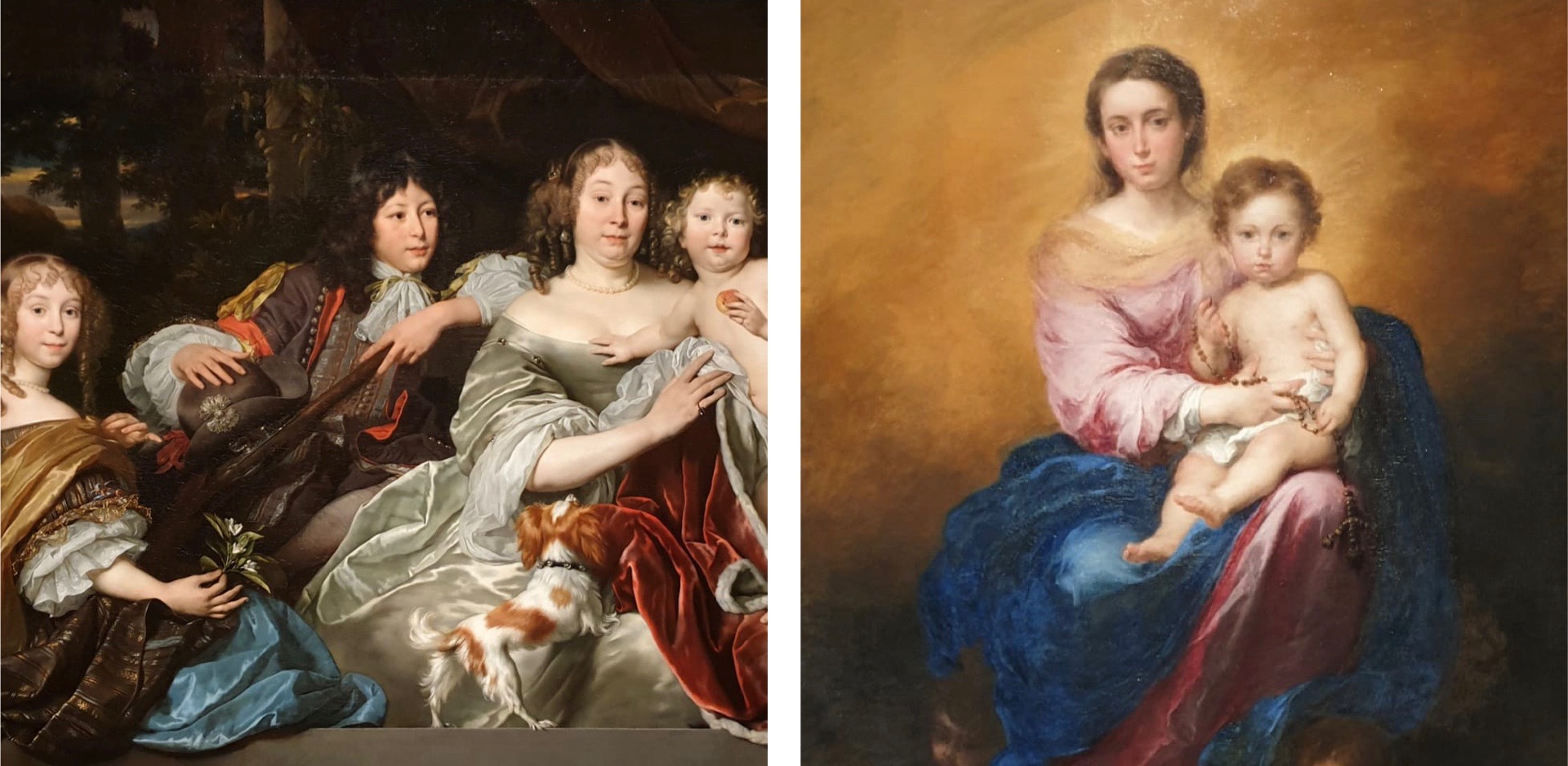
Left: Abraham van den Tempel (1622/1623 -1672) - Portrait of Albertine Agnes with her Children,1668 (see full-size image »), 1668; Right: Bartolomé Esteban Murillo (1617 - 1682) - Madonna of the Rosary, ca. 1675-1680 (see full-size image »)
Mary as the mother of God is extensively venerated in the Catholic Church. As a mother, she experienced all the joys and sorrows of the child Jesus and became a hugely important role model for believers. The image of motherhood is so strongly linked to Mary that it can also be co-opted in a secular representation: Princess Albertine Agnes as an exemplary mother to her children.

Left: Juan van der Hamen y León (1596 - 1631) - Still Life with Artichokes, 1627 (see full-size image »); Right: Willem Claesz Heda (1594 - 1680) - Still Life with a Gilt Goblet, 1635 (see full-size image »)
Profusion and diversity are the key to creating a fascinating composition of objects. This applies to a painter of stories, but also of still lifes. But how should a number of beautiful objects that differ so greatly be combined in a single composition in such a way as to delight the eye? These are challenges to which the Spanish and Dutch painters found their own solutions.
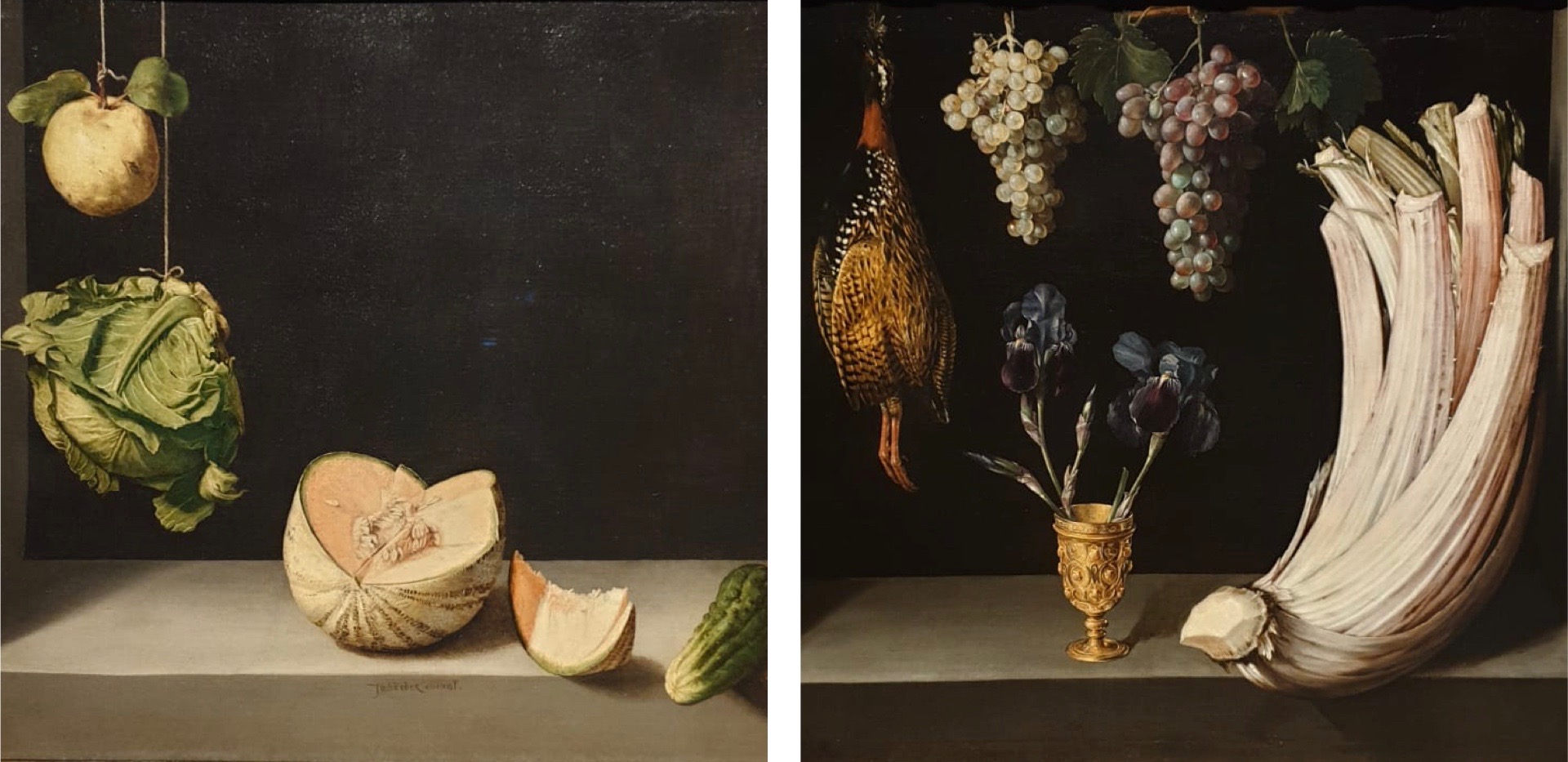
Left: Juan Sánchez Cotán (1560 - 1627) - Still Life with Melon and Cucumber, ca. 1602 (see full-size image »); Right: Felipe Ramirez (1628/1631 - ? ) - Still Life with Cardoon and Grapes, 1628 (see full-size image »)
Illusionistic effects are proof that painters are strongly inclined to push the boundaries of what can actually be depicted. By suggesting depth and rendering everyday objects as realistically as possible Cotán and Ramirez created still lifes that can hardly be distinguished from real ones. Once hung on the wall, the painted niche seems to merge into the existing architecture.
 Left: Master of the Amsterdam Bodegón - Kitchen Scene, ca. 1610 - 1625 (see full-size image »); Right: Diego Velázquez (1599 - 1660) - Old Woman Frying Eggs, 1618 (see full-size image »)
Left: Master of the Amsterdam Bodegón - Kitchen Scene, ca. 1610 - 1625 (see full-size image »); Right: Diego Velázquez (1599 - 1660) - Old Woman Frying Eggs, 1618 (see full-size image »)
The appreciation of everyday objects was reinforced by the ever-increasing role that realism began to play in the 17th-century art. Glass, porcelain, silver, the texture of fruit, dead animals hanging or laying on a table: all of these elements were readily found in domestic surroundings and represented a veritable challenge by means of which painters could convince the public of their artistic merits.
The exhibition has been curated by Gregor Weber, the head of the Rijksmuseum’s Fine and Decorative Arts Department, and assistant curator Cèlia Querol Torelló.
The exhibition design is by the French designer Jean Michel Wilmotte.
2019 – Rembrandt and the Dutch Golden Age
This year is the 350th anniversary of the death of Rembrandt van Rijn (1606-1669), reason enough to honour Rembrandt and devote extra attention to the artist, his work, his contemporaries and the 17th century. The year-long theme of Rembrandt and the Dutch Golden Age brings all these aims together, with many exhibitions and activities taking place around the Netherlands.
In 2019, NBTC Holland Marketing, the Fries Museum, the Mauritshuis, the Rembrandt House Museum, the Rijksmuseum, Museum De Lakenhal, the Amsterdam Museum, the Jewish Cultural Quarter, Museum Prinsenhof Delft, the National Maritime Museum in Amsterdam, and the Amsterdam city archive are working together with cities including Amsterdam, Delft, The Hague, Dordrecht, Enkhuizen, Haarlem, Hoorn, Leiden and Middelburg on Rembrandt and the Dutch Golden Age.
For an overview of all activities and partners, please visit Rembrandt-2019.nl
LOT-ART SERVICES
Art Investment Advisory: proposing a financial approach to art collecting, Lot-Art offers a synergic cluster of tools for optimal investment decision-making in art-related assets. Lot-Art can help you selecting artworks & luxury collectibles with the highest degree of liquidity and opportunity of return. This service will best serve privates and institutions who wish to invest in art as an asset class but don’t have the expertise to unveil and select the best deals in the global art market, Download the Art Investment brochure.
Valuate & Sell: you can appraise for FREE the value of your art & collectibles with the purpose of selling at auction. Disclose the monetary value of your assets, request a free valuation »
Buy Now: Lot-Art has added, aside to auctions browsing, the opportunity to search artworks from trusted art collectors, artists and galleries. If you are not yet acquainted with the thrill of bidding at auction you can just buy selected artworks and luxury assets in perfect relax proposing your offer through the Lot-Art Gallery.
Discover more Highlights & Explore the Financial side of Art on Lot-Art.com
Disclose the value of your assets, request a free valuation
LOT-ART | The Art Investment Platform
Other interesting articles
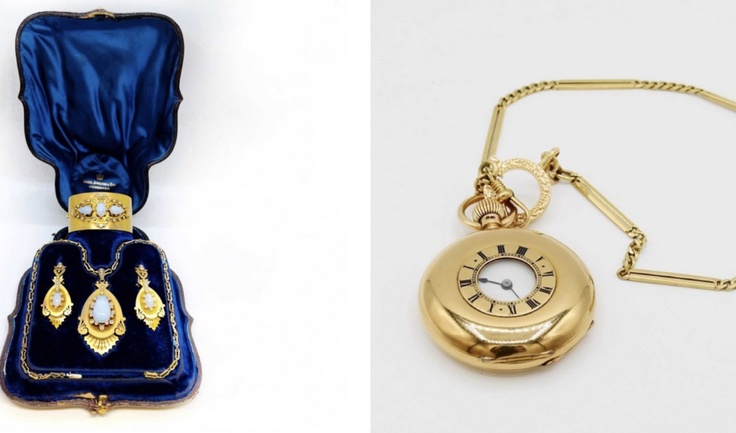
|
Tue Apr 23 2024
A Selection of Jewelry at Casa d'Aste Guidoriccio, ItalyCasa d'Aste Guidoriccio, Italy presents the Auction: "Jewels. A Selection of Jewelry and Precious from Private Collections" on April 30th. Discover the Auction Highlights or browse the full catalogues here » SELECTED LOTS LEFT: Platinum and Diamond Ring, Fabergé Victor Mayer Collection. Diamonds totalling 0.78 ct. Limited series 11/100. See Price Estimate... RIGHT: 750... |
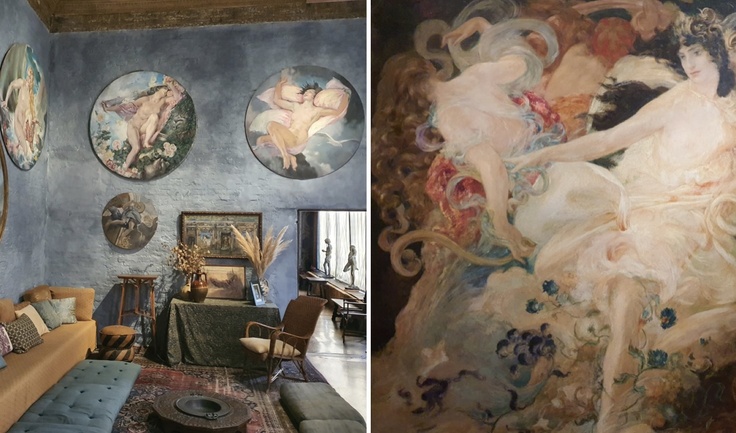
|
Mon Apr 22 2024
Enchantment at Palazzo Fortuny: 'Selva' by Eva Jospin in VeniceLEFT: Photograph of the Mariano Fortuny Y Madrazo Museum; RIGHT: Wagnerian Cycle. Parsifal. The Flower Maidens, Mariano Fortuny y Madrazo, 1896 Mariano Fortuny y Madrazo, born in Granada in 1871, was a renowned Spanish artist celebrated for his innovative contributions in the realms of fashion, photography, and lighting design. Fortuny gained global fame for the... |
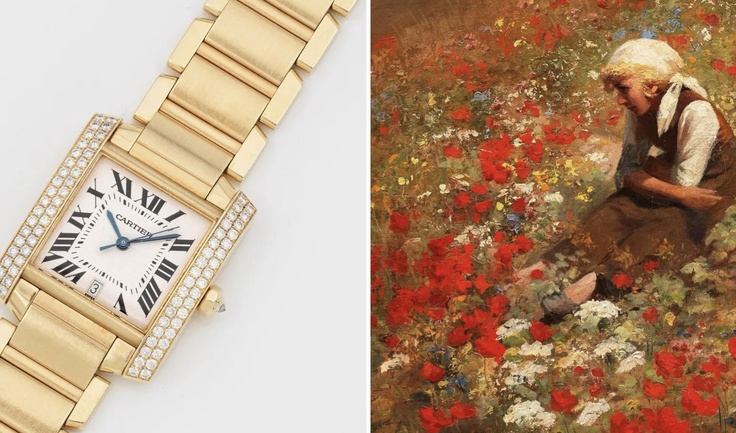
|
Sat Apr 20 2024
International Art at Schloss Ahlden, GermanySchloss Ahlden, Germany presents the 190th International Art Auction in four parts: Part I on 27 April Part II on 28 April Part III on 3 May Part IV on 4 May Discover the Auction Highlights or browse the full catalogues here » SELECTED LOTS LEFT: Lovis Corinth (1858 - 1925) - "Pair of Centaurs" Oil on canvas, laid down on canvas. Signed and dated 1917. See Date & Price... |
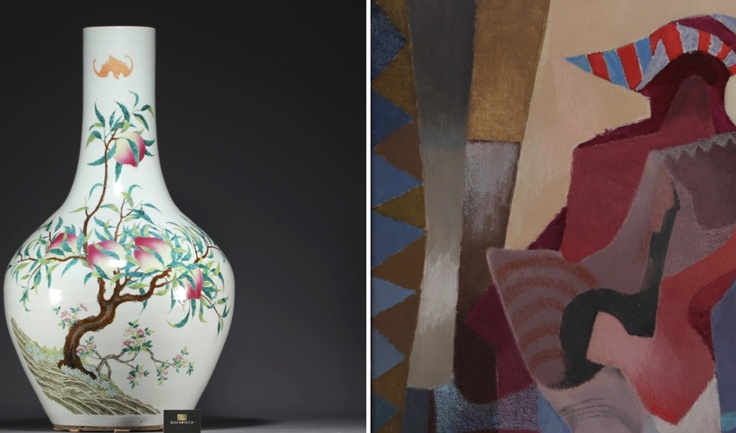
|
Fri Apr 19 2024
Fine & Decorative Art at Goldfield, LuxembourgGoldfield, Luxembourg presents the Auction 'Succession of Baron Lejeune & Miscellaneous' on April 27th. The catalogue features fine art, Asian and ethnographic art, jewellery & watches, silverware, design and classic furniture. Discover the Auction Highlights or browse the full catalogue here » SELECTED LOTS LEFT: Michelangelo Barberi (1787-1867) attr. - Marble table... |